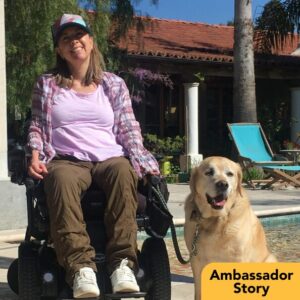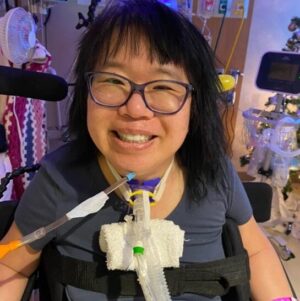Our client Ambassador Ian Burkhart is the Vice President of the North American Spinal Cord Injury Consortium and the President of The Ian Burkhart Foundation.
Ian first found Help Hope Live 13 years ago after a life-changing spinal cord injury.
We asked him why his community chose Help Hope Live, how spinal cord injury fundraising has impacted his life, and what being an Ambassador means to him today.

How has your day-to-day life with paralysis changed over the past 13 years post-injury?
The biggest change is how much I’m able to do that I thought I’d never be able to do again after my injury.
When I experienced my injury at 19 years old, I really had no idea what the future held for me—and it looked bleak.
Over the years, I’ve been able to do some cool things, from returning to school and graduating college to moving out on my own, driving a van, traveling independently, and doing so much that I thought I would never be capable of doing post-SCI.
What has helped you to propel that capability?
There were a few important factors that influenced my independence.
First, I was able to pursue inpatient rehabilitation intensively after injury.
Over time, however, I came face-to-face with the financial impact of that kind of intensive recovery—insurance eventually stopped covering that activity. The cost of recovery continued to be a factor over the years, and community support through Help Hope Live played a crucial role in that area.
Getting cut off from insurance coverage for exercise-based rehab led to the second major area of impact.
I kept looking for more and more that I could do to enhance my life. That process led me to other experimental therapies, including the brain-computer interface (BCI) trial I started in 2014.
In 2021, I had my BCI device removed. While I am no longer actively participating in a BCI trial, I am still working with a few companies in the space, which has been really exciting.
I get to see how things are slowly gaining traction and moving forward.
While everything is still in the research stages, it’s definitely progressing. I’m excited for a future when these kinds of technologies are accessible outside of a clinical trial environment.
Though I benefited from some aspects of the BCI trial only while actively participating, I was also able to benefit from the extra therapy that went along with the trial.
I had movement in some areas post-injury, such as my shoulders and biceps. The trial created an opportunity to strengthen those muscles without having to independently fund intensive rehab to do so.
Unfortunately, so many people cannot access potentially life-changing rehab and technology after a spinal cord injury.
That’s one of the reasons why I help others learn about the prospect of funding some of these pathways through Help Hope Live.
How did your BCI trials lead to you establishing your own nonprofit?
I started The Ian Burkhart Foundation as we were getting a lot of press and recognition for the BCI clinical research I was participating in.
I got lucky in a sense: my story was being shared widely because of how novel and exciting the technology was.
I was contacted by someone who said the story really hit home for them. They had found success in their own professional journey, and they wanted to see how they could help me.
At this point, I was personally in a good place with out-of-pocket expenses.
I had a new wheelchair and most of the equipment I needed to be as independent as possible, but I did have a desire to help others.

I envisioned the nonprofit’s mission fueled by my own understanding of how significant the financial hurdles can be after a spinal cord injury.
For some people like me, a community of support is there, and they want to help after a medical emergency like mine. However, I know there are people out there who don’t have that strong community that is motivated to rally and fundraise.
These people can get locked out of the equipment that can improve their independence and the therapy and experiences that can enhance their quality of life.
We started the nonprofit for that reason—to provide another pathway for meeting those life-enhancing needs.
It’s been an exciting experience, and it scratches some of my itch of wanting to be my own boss and start my own business.
It’s been fantastic seeing the tangible impact when I know firsthand exactly what it’s like to go through the struggle of not being able to do what you want to do after an injury—and the challenge of seeing amazing equipment that could make a difference in your life, but insurance won’t cover it, and you can’t afford it.
It’s inspiring—even funding something as simple as a ramp to get in and out of a house independently, or a shower chair so you can bathe on your own, or any equipment that can help you do something faster as you establish your day-to-day life with as much independence and possible.
You started fundraising with us just one month after your injury. Why did your community choose Help Hope Live?
We found Help Hope Live through a childhood friend’s mom, who had heard that Help Hope Live had a program to help individuals with spinal cord injuries to fundraise.
It was an amazing find for us, because at the time, crowdfunding was not yet a common term or concept.
We were considering starting a trust to give our community a pathway to help, but Help Hope Live was easier.
I was still on my parents’ health insurance at the time, but so much wasn’t covered by insurance. Because we couldn’t immediately cover the cost of home modifications, when I left the hospital after my injury, I had to transition to a nursing home.
As a 19-year-old, I was the youngest person in the nursing home by 40 years.
In addition to those critical home modifications, which insurance wouldn’t cover, we needed reliable and safe transportation. We also needed a way to cover costs that might come up if anything happened to my power chair. While the power chair itself was covered by insurance, repairs and backup mobility devices were not covered.
If my power chair broke down, I’d be stuck in bed.
A backup manual wheelchair was a key but uncovered expense. These and other vital items and expenses helped me to make my way back into life.

Today, are you still actively fundraising? Have your out-of-pocket expenses changed?
Even though there are many expenses insurance overs directly after a spinal cord injury, there are still expenses I have to continuously cover to maintain my independence and mobility.
One key expense is a wheelchair van.
After about 10 years, a wheelchair van will typically start to show significant signs of wear and tear, and over time, an older van will no longer be safe or reliable to drive.
Thanks to the fundraising campaign with Help Hope Live, I was able to purchase a new van this spring.
In another 10 years, I’ll likely be right back in the same position of needing to replace my van. It’s an ongoing need—dependable transportation is so vital to quality of life and being a member of the community.
Aside from transportation, little things always come up here and there that insurance just doesn’t cover – for example, if I need any modifications to my current home setup.
My fundraising campaign will be a key source of support to keep me independent.
Why have you stayed with Help Hope Live for fundraising over these 13 years?
I believe fundraising with Help Hope Live is vital for anyone who wants to improve their quality of life after injury.
I have always loved the support that I’ve received from the Help Hope Live team.
The platform makes gathering community support so easy—I can engage in a set-it-and-forget-it fundraising strategy without intensive management on my side, backed by that one-on-one support when I need it.
It’s fantastic to offer donors an opportunity to make a tax-deductible donation.
In addition to that benefit, donors also have the added security and confidence that all donations will be used to cover verified medical and related expenses.
Donations are not going into my pocket to buy a new TV or go to sporting events.
You can put donors at ease knowing funds raised through Help Hope Live will always be used for the right reasons.
In addition to these benefits for donors, it’s a major distinction over other fundraising options like GoFundMe that all donations go directly to Help Hope Live and therefore won’t jeopardize my benefits or prevent me from accessing resources through state and federal programs.
It’s frustrating to see people with spinal cord injuries penalized for fundraising for what insurance doesn’t cover.
No one should have to jeopardize their benefits just because they’re fundraising for critical expenses. Uncovered expenses and therapies can indeed be life-changing.
With Help Hope Live, they can protect themselves from being punished just for fundraising for what they truly need.
A lot of people have the means to collect community support after an injury, but communities often aren’t sure what to do to help.
Help Hope Live gives communities a platform where they can take action and help in a way that’s safe and trustworthy.
Ultimately, my experience with Help Hope Live has genuinely lived up to the organization’s mission statement.

What does hope mean to you?
Especially right after my injury, there were times when I had zero or negative hope that I had a future ahead of me.
So many things have helped restore that hope for me—and one is my community rallying around me.
The research I’ve been able to participate in gives me a sense that technology and medicine are progressing in a way that will hopefully benefit myself and others in the future. That gives me a sense of excitement and hope, too.
Today, hope means to me that every day will get a little bit better and the future is worth living for.
Connect with Ian on his Campaign Page and keep up with his nonprofit work through The Ian Burkhart Foundation.
Written by Emily Progin










